Sumatra, an island in western Indonesia, is a haven for bird enthusiasts. This island is home to a plethora of bird species, with over 400 species recorded.
Sumatra boasts a diverse landscape of forests, mountains, rivers, and coastlines, providing habitats for many bird species. From majestic birds of prey to colorful songbirds, Sumatra’s avian population is truly a sight to behold.
Whether you’re an ornithologist, a birdwatcher, or simply a nature lover, Sumatra’s birdlife is sure to captivate you. In this article, we will take a closer look at the various bird species that inhabit Sumatra and explore some of the island’s top birding destinations.
1. Painted-Snipe

Painted snipes are beautiful and unique wading birds found in the Rostratulidae family. They have short legs, long bills, and a striking plumage which distinguishes them from true snipes.
Males tend to be smaller than females with duller overall coloration. There are three species of painted snipe.
The Greater Painted Snipe, Lesser Painted Snipe, and Australian Painted Snipe – all three have different habitats ranging from wetland pools to grasslands or mangroves depending on their region.
These birds feed mainly on earthworms but also consume insects, crustaceans and plant material when available.
As they rely heavily on wetlands for breeding purposes it is important that we protect these precious habitats so that this special bird can continue to thrive.Scientific classification:
| Kingdom | Animalia |
| Phylum | Chordata |
| Class | Aves |
| Order | Charadriiformes |
| Suborder | Thinocori |
| Family | Rostratulidae Coues, 1888 |
Also Featured In: Most Common Birds in China, Most Common Taiwan Birds
2. Heliornithidae
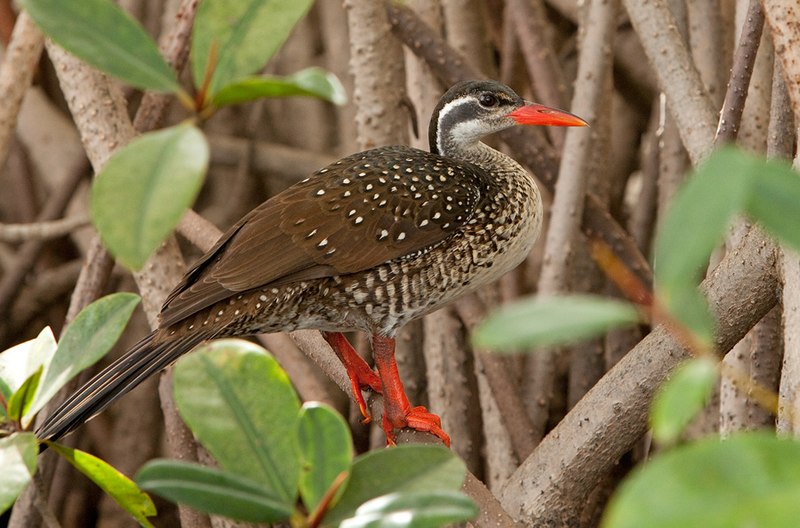
Heliornithidae, commonly known as finfoots, are a small family of tropical birds found in South America and Africa. They have webbed feet like grebes or coots, long necks, slender bodies and broad tails with sharp pointed bills.
Their diverse calls include whistles, squawks and croaks which they use to communicate with each other.
Finfoots feed mainly on fish but also consume insects such as water beetles and dragonflies near the surface of waterbodies.
They nest around rivers or lakes where there is plenty of cover from predators such as eagles or hawks.
During breeding season males can become quite territorial defending their territories against intruders by chasing them off aggressively using loud noises or even physical contact if necessary.Scientific classification:
| Kingdom | Animalia |
| Phylum | Chordata |
| Class | Aves |
| Order | Gruiformes |
| Family | Heliornithidae GR Gray, 1840 |
Also Featured In: Beautiful Brazilian Birds, Birds that Live in Guyana
3. Dark-Necked Tailorbird
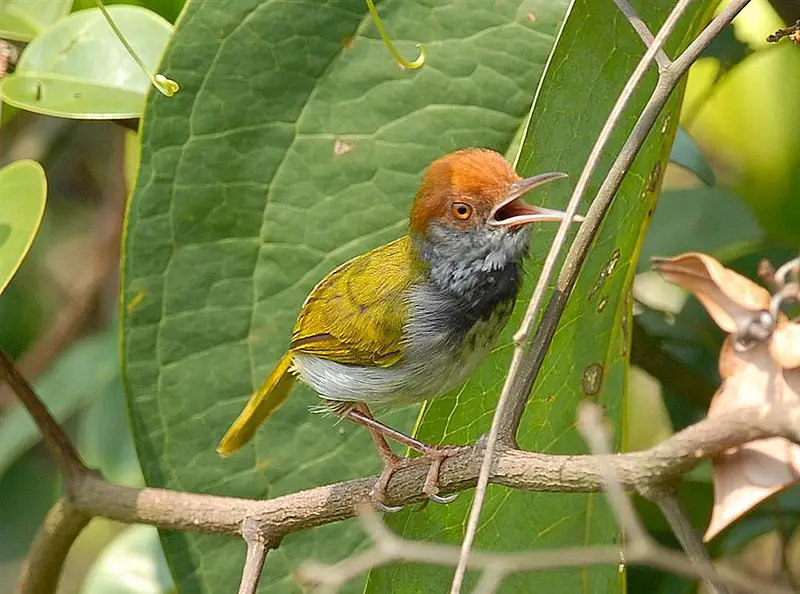
The Dark-necked Tailorbird is a small songbird species that belongs to the Cisticolidae family. It can be found in Bangladesh, Northeast India and Southeast Asia, where it inhabits subtropical or tropical moist lowland forests as well as mangrove forests.
This bird has an olive-brown upper body with dark streaks on its wings and tail while its underside is yellowish white with grey flanks.
The head of this species has distinct black stripes running from behind the eye down onto neck which gives it its name – “Dark-Necked”.
Its call sound like ‘dzeet’ and they are usually heard during morning hours when these birds sing in pairs or groups perched high up in trees.Scientific classification:
| Kingdom | Animalia |
| Phylum | Chordata |
| Class | Aves |
| Order | Passeriformes |
| Family | Cisticolidae |
| Genus | Orthotomus |
| Species | O. atrogularis |
Also Featured In: Most Common Types of Bangladeshi Birds,
4. Pittas
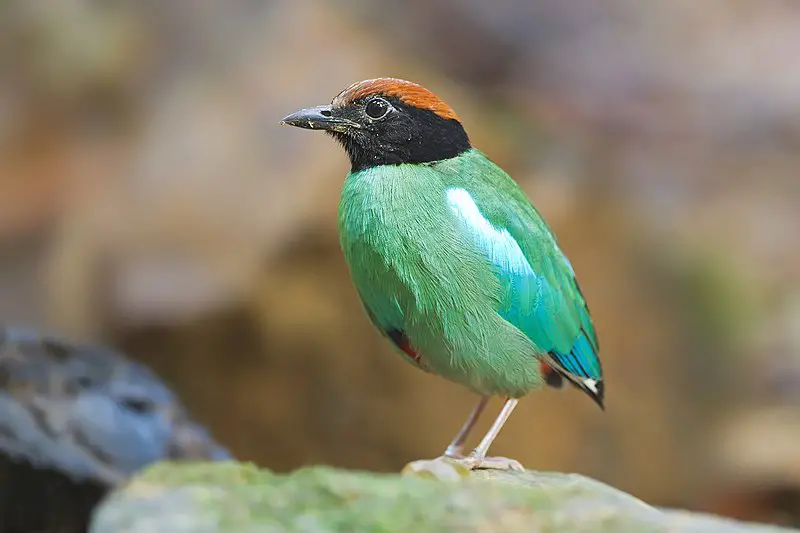
Pittas are a family of passerine birds known for their vibrant colors and unique appearance. They can be found in Asia, Australasia and Africa with around 40 to 42 species existing today.
These Old World suboscines have closest relatives among other bird genera such as Smithornis and Calyptomena.
Pittas inhabit tropical forests where they hop from branch to branch searching for insects or worms on the ground below them.
Their feathers are stunningly colored with combinations of blue, green, copper, purple or even yellow making them stand out amongst others in the forest canopy.Scientific classification:
| Kingdom | Animalia |
| Phylum | Chordata |
| Class | Aves |
| Order | Passeriformes |
| Suborder | Tyranni |
| Infraorder | Eurylaimides |
| Superfamily | Pittoidea |
| Family | Pittidae Authority disputed.[a] |
Also Featured In: Birds of the Philippines, Asian Birds
5. Leafbird
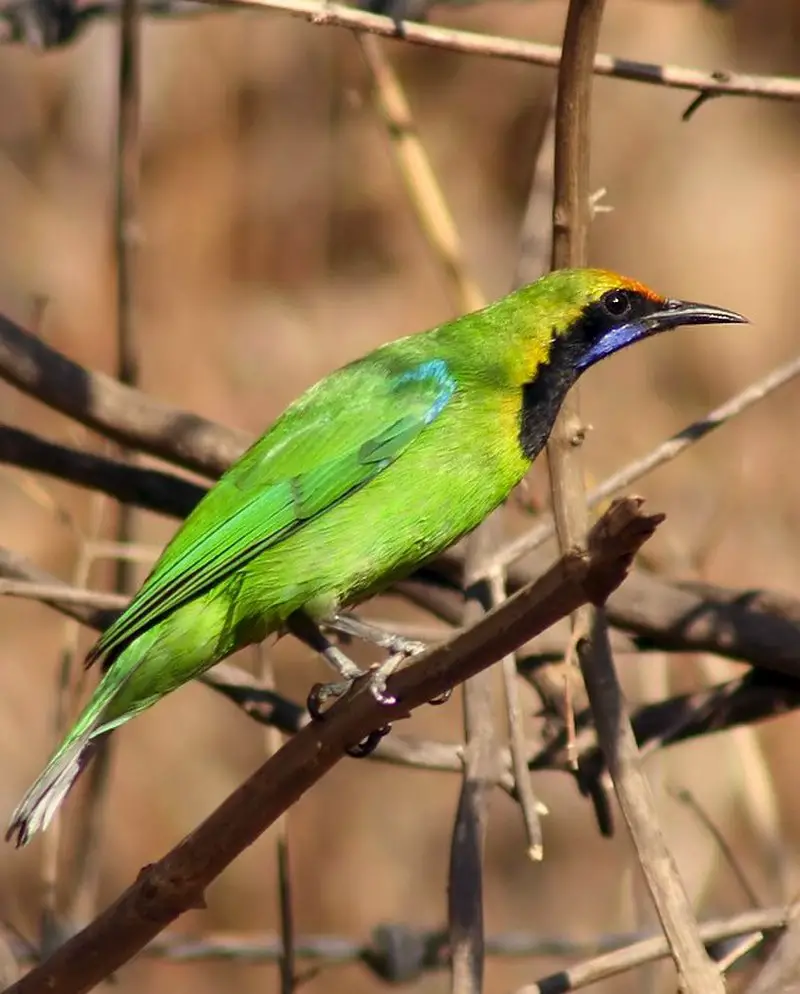
Leafbirds are small passerine birds found in the Indian Subcontinent and Southeast Asia. They range from 14 to 21 cm, with a weight of about 19-40 grams.
Leafbirds have bright colours such as green, blue and yellow on their head, throat and wings which make them stand out among other species. The males typically have brighter colouration than females.
Their diet consists mainly of fruits but they also eat insects occasionally. These birds live in pairs or family groups that share territories year round while migrating during winter months to warmer climates for breeding purposes.
Although leafbird populations remain stable across much of its habitat, these birds are threatened by deforestation due to urbanization and agricultural expansion leading to loss of suitable nesting sites causing decline in population numbers throughout certain areas within their rangeScientific classification:
| Kingdom | Animalia |
| Phylum | Chordata |
| Class | Aves |
| Order | Passeriformes |
| Family | Chloropseidae Wetmore, 1960 |
| Genus | Chloropsis Jardine & Selby, 1827 |
6. Laughingthrushes
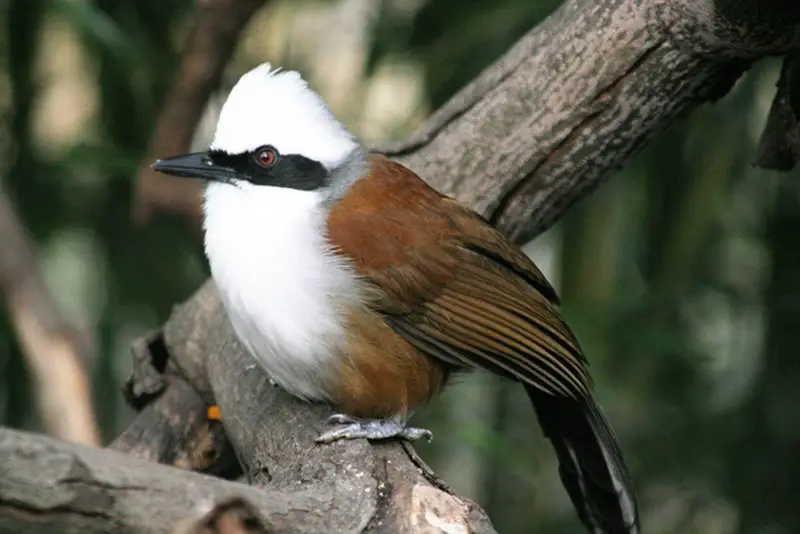
Laughingthrushes are a family of passerine birds found in tropical areas, primarily Southeast Asia and the Indian subcontinent.
They vary greatly in size and coloration but generally they have strong legs and many species are terrestrial or semi-terrestrial.
These birds typically inhabit forests where they feed on insects, fruits, seeds and occasionally small vertebrates.
The diet varies depending on the species as some prefer to forage among foliage while others look for food along the forest floor or take it from trees high up in their habitat.
In general these active creatures live in flocks that can range from just a few individuals to large groups with dozens of members making them quite vocal at times.Scientific classification:
| Kingdom | Animalia |
| Phylum | Chordata |
| Class | Aves |
| Order | Passeriformes |
| Superfamily | Sylvioidea |
| Family | Leiothrichidae Swainson, 1832 |
Also Featured In: Birds of Morocco, Birds That Live in Iraq
7. Ferruginous Partridge
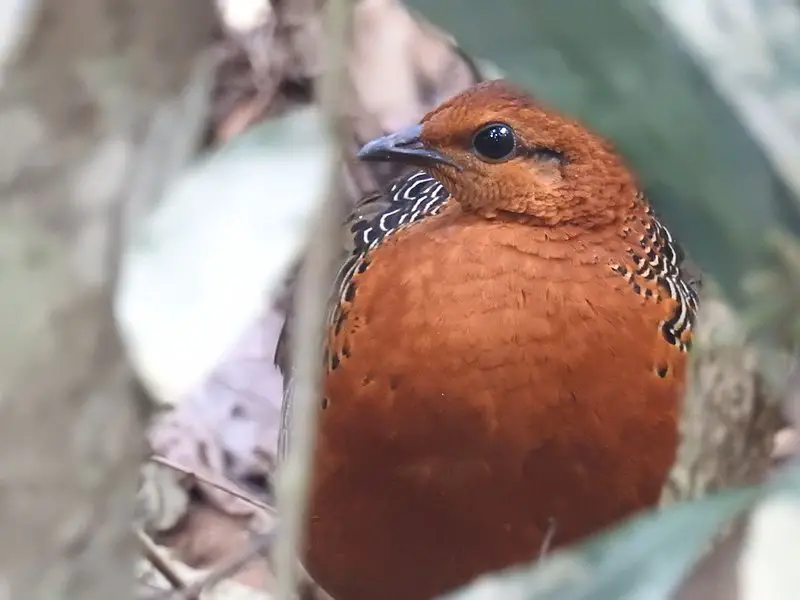
The Ferruginous Partridge is a species of bird belonging to the family Phasianidae and genus Caloperdix. It can be found in Indonesia, Malaysia, Myanmar and Thailand.
Coenraad Jacob Temminck first described it as Perdix oculea in 1815, where its specific name ‘oculea’ referred to Latin for eyes meaning that its feathers were covered with many small spots resembling eyes.
Its upperparts are rufous-brown or chestnut color while underparts have white bars on flanks which contrast against dark brown breast plumage making it look attractive.
These birds generally live alone or form pairs during breeding season but they become social when feeding together at nightfall near waterholes and farmlands like other partridges do.
The diet consists mainly of insects, grains and seeds though they also feed on snails occasionally along with fruits from trees such as jackfruit tree too.Scientific classification:
| Kingdom | Animalia |
| Phylum | Chordata |
| Class | Aves |
| Order | Galliformes |
| Family | Phasianidae |
| Subfamily | Rollulinae |
| Genus | Caloperdix Blyth, 1861 |
| Species | C. oculeus |
Also Featured In: Beautiful Malaysian birds,
8. Chestnut-Capped Laughingthrush
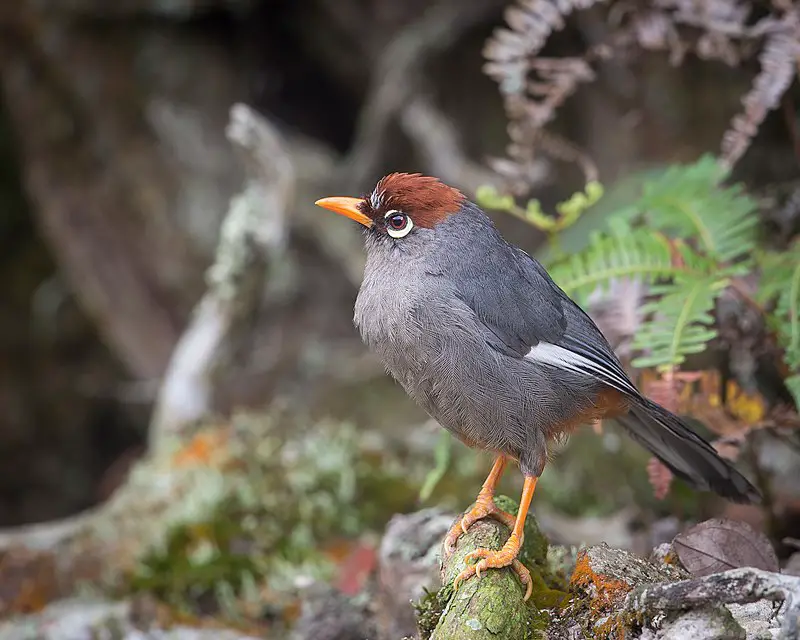
The Chestnut-capped Laughingthrush is a beautiful species of bird found in Sumatra and the Thai-Malay Peninsula.
They usually inhabit subtropical or tropical moist lowland forests and subtropical or tropical montane forests, where they can find their food sources such as insects, fruits, and seeds.
These birds are easily identified by its chestnut hood which extends to cover most of its head with white spectacles around the eyes. The body plumage is mostly greyish brown while underneath it has black barring on a pale yellow undertail coverts.
It was previously considered conspecific with Pterorhinus insularis but now recognized as distinct species due to differences in vocalizations and morphology.Scientific classification:
| Kingdom | Animalia |
| Phylum | Chordata |
| Class | Aves |
| Order | Passeriformes |
| Family | Leiothrichidae |
| Genus | Pterorhinus |
| Species | P. mitratus |
9. Fire-Tufted Barbet
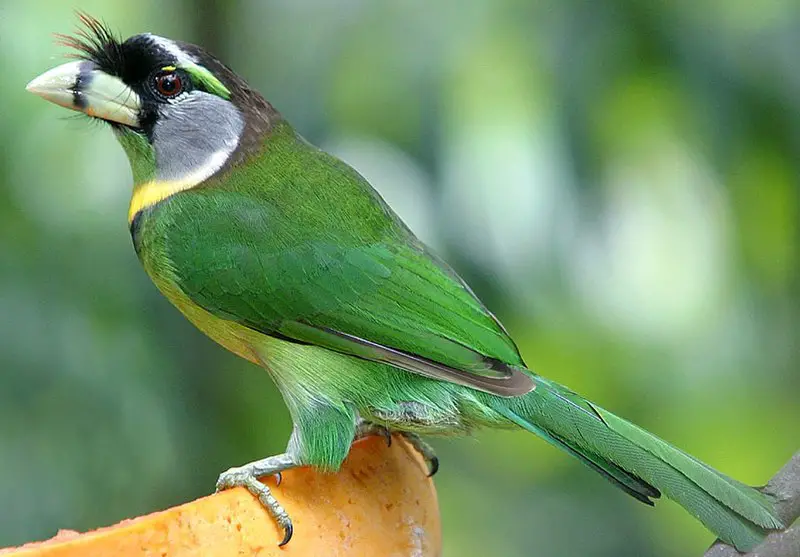
The Fire-tufted Barbet is a beautiful species of bird found in Peninsular Malaysia and Sumatra. It has bright red feathers on its head, giving it the name fire-tufted barbet.
The rest of its body is green with blue patches near the wings, making it quite distinctive among other birds. This species inhabits tropical moist lowland and montane forests where they feed mainly on fruits, insects and nectar from flowers.
As an endangered species according to IUCN Red List 2004, efforts are being made to protect this lovely bird’s habitat so that future generations can enjoy its beauty for years to come.Scientific classification:
| Kingdom | Animalia |
| Phylum | Chordata |
| Class | Aves |
| Order | Piciformes |
| Family | Megalaimidae |
| Genus | Psilopogon |
| Species | P. pyrolophus |
10. Red-Crowned Barbet
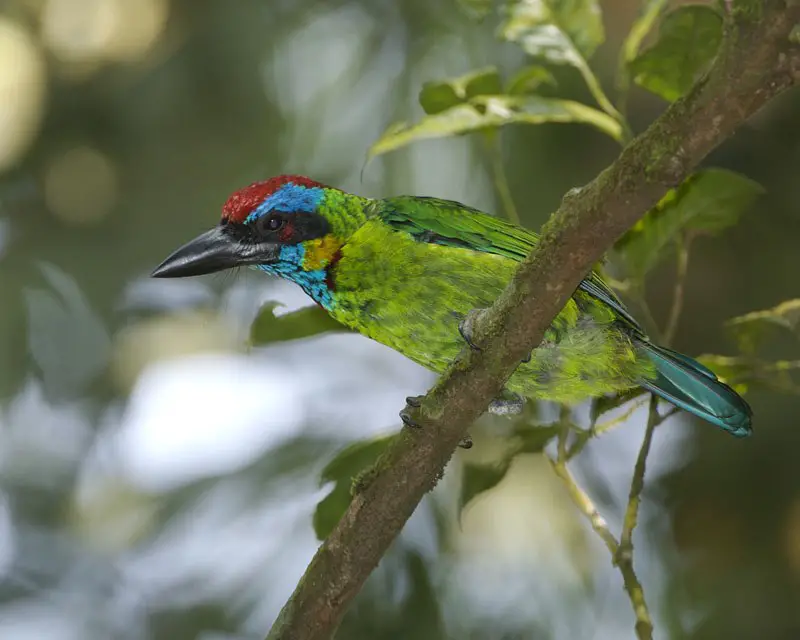
The Red-crowned Barbet is a species of bird found in Brunei, Indonesia, Malaysia, Myanmar, Singapore and Thailand. It has an average length between 24.5�27 cm (9.6�10.6 in) with weights ranging from 99 to 150 grams (3.5 � 5.3 oz).
The barbets are characterized by their bright red crowns which distinguish them from other birds in the Megalaimidae family.
They inhabit moist lowland forests and plantations where they feed mainly on fruits as well as some insects for additional protein sources.
Unfortunately these impressive birds are threatened due to increasing habitat loss caused by human activity such as deforestation and agricultural expansion leading to decreased resources available for sustenance of this species.Scientific classification:
| Kingdom | Animalia |
| Phylum | Chordata |
| Class | Aves |
| Order | Piciformes |
| Family | Megalaimidae |
| Genus | Psilopogon |
| Species | P. rafflesii |
11. Ashy Tailorbird
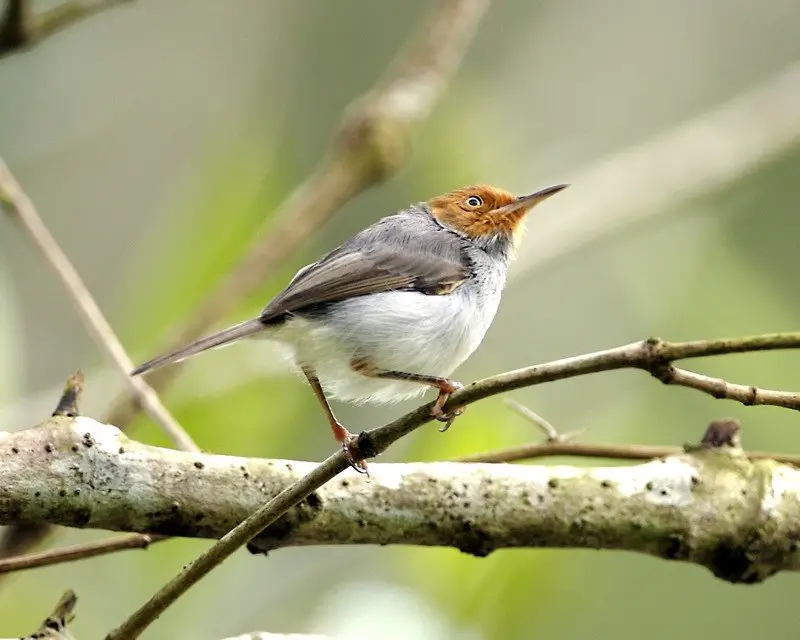
The ashy tailorbird is a species of bird found in parts of Southeast Asia such as Brunei, Indonesia, Malaysia and Vietnam. It has distinctive rufous crowns that make it easy to identify among other birds.
This small passerine typically inhabits subtropical or tropical lowland forests and mangrove swamps.
They are usually seen singly or in pairs foraging on the ground for insects and larvae, which they pluck out using their pointed beaks.
The males also have an elaborate courtship ritual involving song-and-dance displays accompanied by tail fanning while perched at the tops of trees.
These energetic little birds pose no threat to humans but can prove beneficial with many pest control services offered during their busy breeding season.Scientific classification:
| Kingdom | Animalia |
| Phylum | Chordata |
| Class | Aves |
| Order | Passeriformes |
| Family | Cisticolidae |
| Genus | Orthotomus |
| Species | O. ruficeps |
Also Featured In: Brunei birds,
12. Cerulean Kingfisher
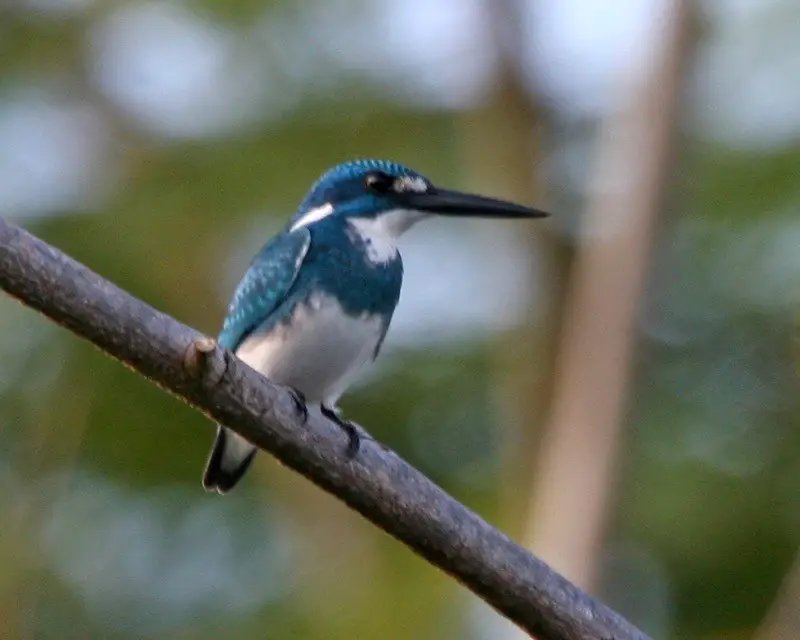
The Cerulean Kingfisher is a beautiful bird found in parts of Indonesia. It has an overall metallic blue colouring, making it look very similar to the common kingfisher – however, this species features white underneath instead of orange.
Males are typically bluer than females which have a more greenish cast. This type of kingfisher is sometimes referred to as the “small blue kingfisher” in Indonesia and elsewhere but should not be confused with other small birds that share its name.
Due to their unique plumage they can easily be distinguished from other species when seen up close or even at a distance depending on light conditions.
The Cerulean Kingfishers’ bright colours make them one of the most iconic members amongst Indonesian wildlife.Scientific classification:
| Kingdom | Animalia |
| Phylum | Chordata |
| Class | Aves |
| Order | Coraciiformes |
| Family | Alcedinidae |
| Subfamily | Alcedininae |
| Genus | Alcedo |
| Species | A. coerulescens |
Also Featured In: Kingfishers Species, Java Birds You Should Know
13. Storm’s Stork
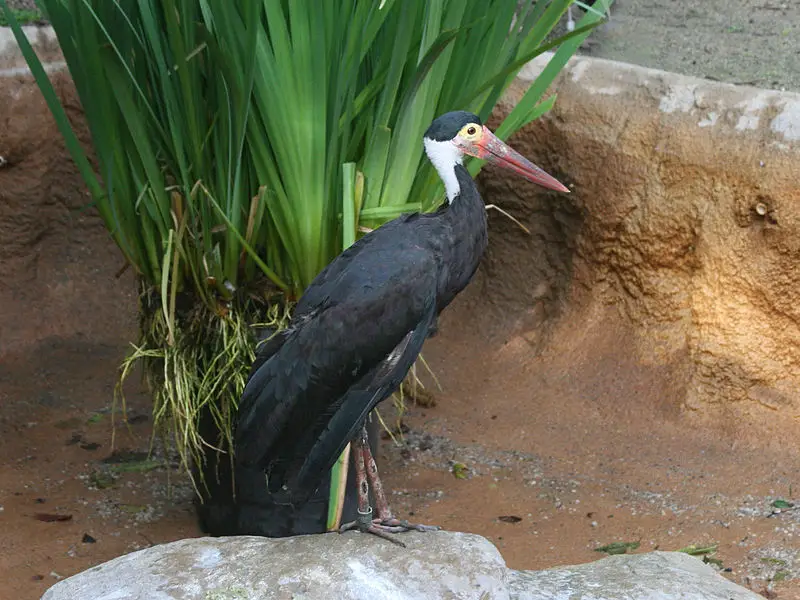
Storm’s stork is a rare species of bird found in the lowland tropical forests of Indonesia, Malaysia and Thailand. It has an estimated population size of fewer than 500 individuals worldwide.
The primary cause for its decline is believed to be deforestation in their natural habitat leading to destruction or degradation of suitable nesting sites.
Hunting by humans also impacts the numbers as does competition for food with other animals such as pigs, primates and cattle which are present in some areas where Storm’s Storks live.
Conservation efforts have been ongoing since 2000 and involve nest protection schemes, public education campaigns and research into the birds’ behaviour & ecology but much more needs to be done if this beautiful yet vulnerable species is going to survive long-term.Scientific classification:
| Kingdom | Animalia |
| Phylum | Chordata |
| Class | Aves |
| Order | Ciconiiformes |
| Family | Ciconiidae |
| Genus | Ciconia |
| Species | C. stormi |
Also Featured In: Stork Species,
14. Silvery Pigeon
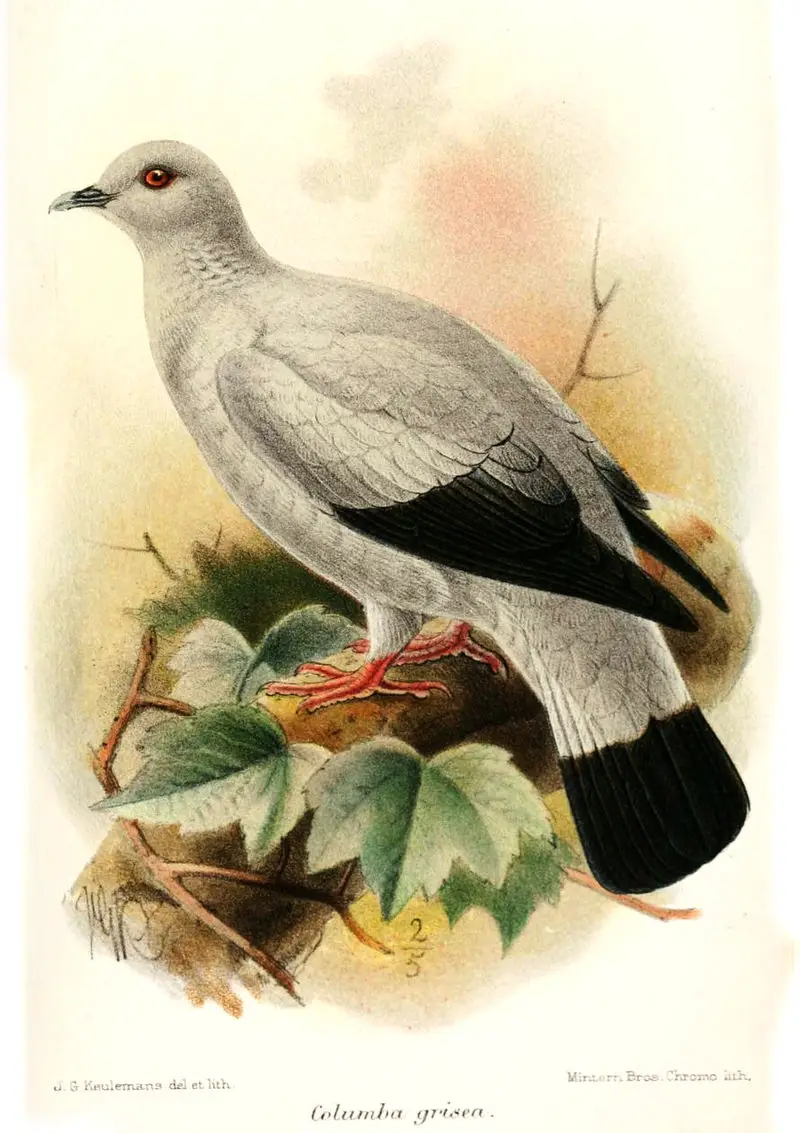
The Silvery Pigeon, also called the Grey Wood-Pigeon, is a bird species found in Indonesia and Malaysia.
This pigeon was previously believed to be extinct, but recent discoveries in Masokut Island suggest that it may still exist.
Pictures from Simeulue also confirm the existence of this bird species. The Silvery Pigeon is very similar in appearance to the Pied Imperial Pigeon and is difficult to distinguish.Scientific classification:
| Kingdom | Animalia |
| Phylum | Chordata |
| Class | Aves |
| Order | Columbiformes |
| Family | Columbidae |
| Genus | Columba |
| Species | C. argentina |
Also Featured In: Silver Birds You Should Know, Birds that Live in Borneo Island
15. Sunda Blue Flycatcher
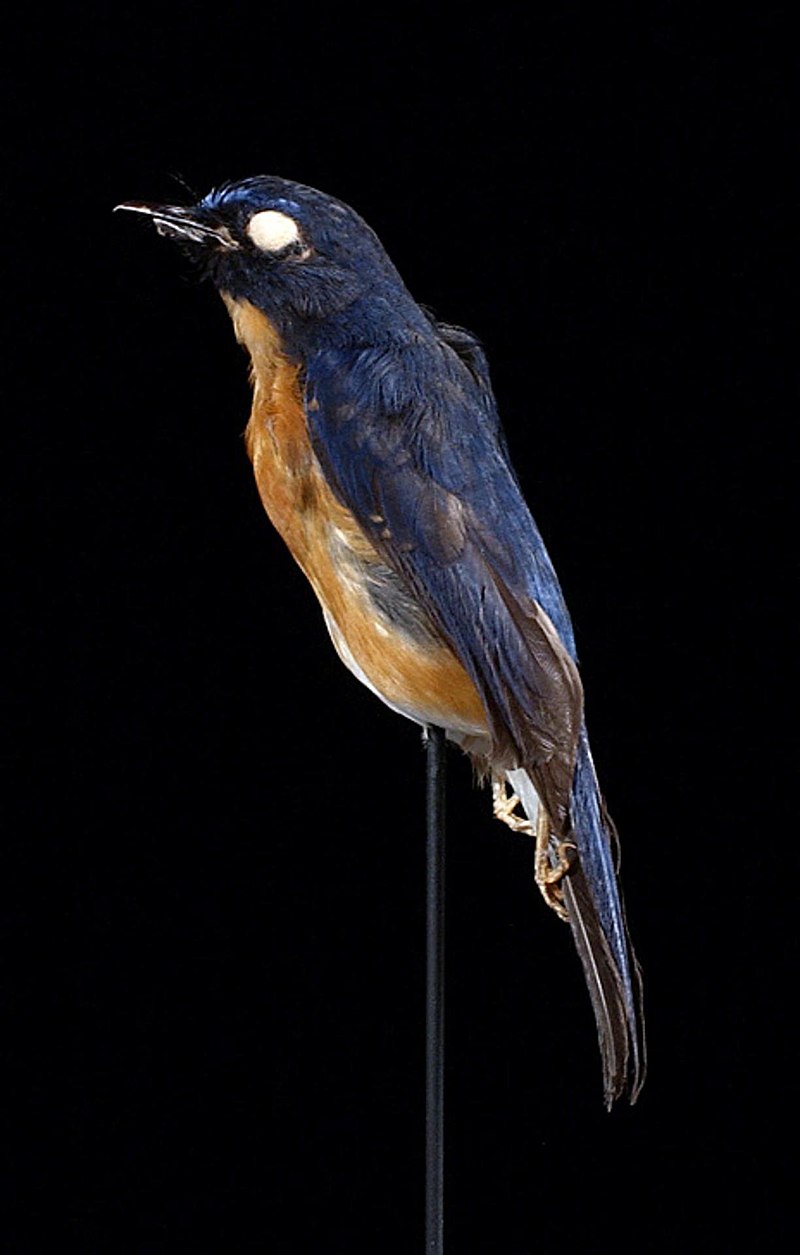
The Sunda blue flycatcher, also called the large-billed blue-flycatcher, can be spotted in Sumatra and Borneo. This bird belongs to the family Muscicapidae and prefers living in subtropical or tropical moist lowland forests.
Sadly, its existence is endangered because of habitat loss.Scientific classification:
| Kingdom | Animalia |
| Phylum | Chordata |
| Class | Aves |
| Order | Passeriformes |
| Family | Muscicapidae |
| Genus | Cyornis |
| Species | C. caerulatus |
16. Bar-Winged Prinia
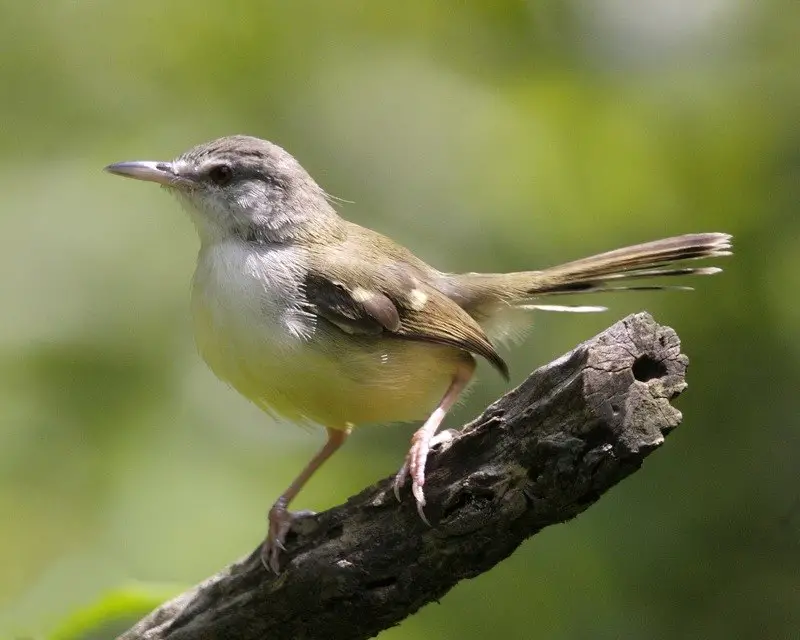
The bar-winged prinia, also known as the bar-winged wren-warbler, is a small bird from the cisticola family. It is approximately 13 centimeters long and weighs between 8 to 10 grams.
This bird species is endemic to Indonesia and can be found on Sumatra’s eastern part, including the islands of Java and Bali. Its distinctiveness is most noticeable by its bar-shaped wings.
The bar-winged prinia is a beautiful bird, but sadly, its population is decreasing due to habitat loss and fragmentation. Conservation efforts are being put in place to protect this unique species for future generations to enjoy.Scientific classification:
| Kingdom | Animalia |
| Phylum | Chordata |
| Class | Aves |
| Order | Passeriformes |
| Family | Cisticolidae |
| Genus | Prinia |
| Species | P. familiaris |
Also Featured In: Birds that Commonly Found in Bali,
17. White-Headed Munia
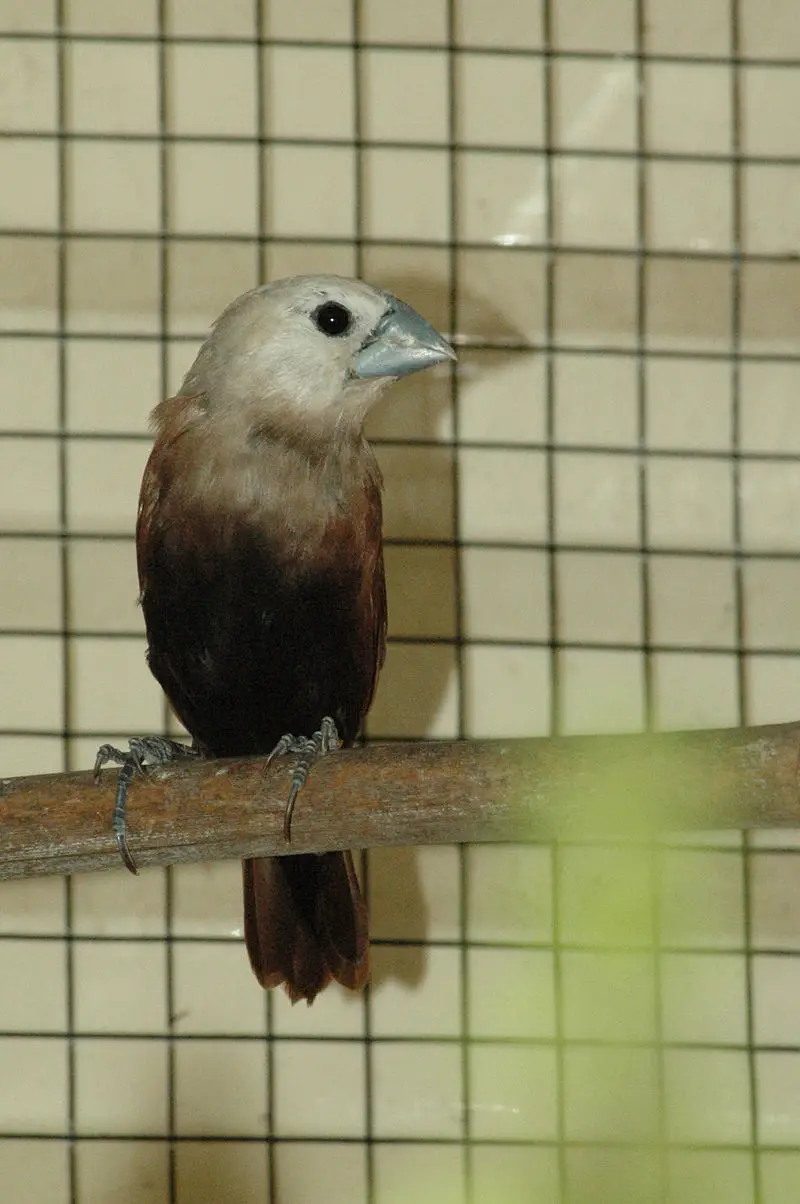
The white-headed munia is a small bird from the finch family. It can be found in wetlands in Teladan, Malaysia, Singapore, Thailand and Vietnam, and has also been introduced to Portugal.
This bird has a white head and is evaluated as a species of Least Concern. The Swedish naturalist Carl Linnaeus described the white-headed munia in his Systema in 1766.Scientific classification:
| Kingdom | Animalia |
| Phylum | Chordata |
| Class | Aves |
| Order | Passeriformes |
| Family | Estrildidae |
| Genus | Lonchura |
| Species | L. maja |
18. Javan Munia
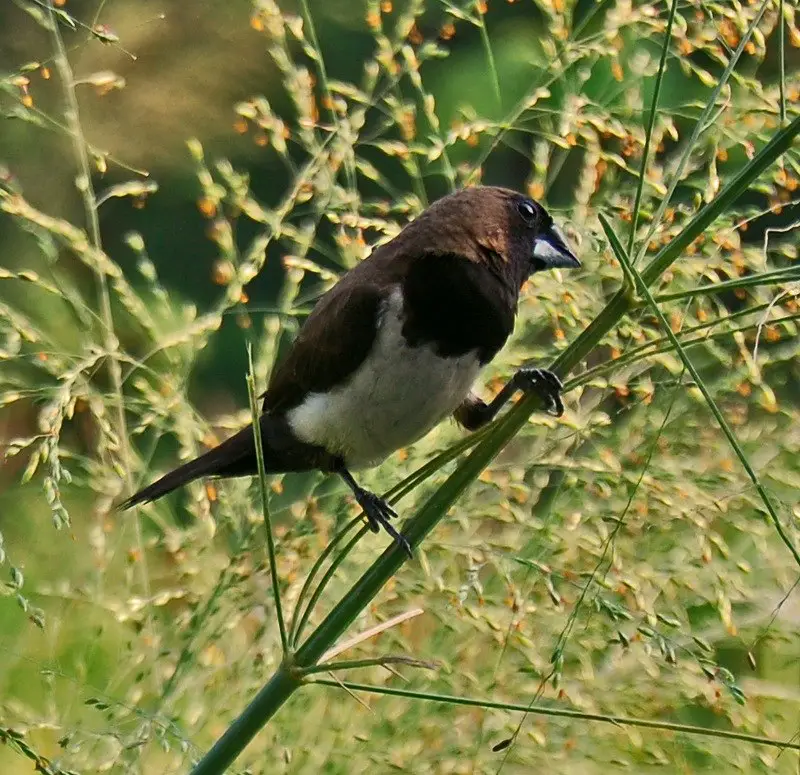
The Javan munia bird is a small finch species that can be found in southern Sumatra, Java, Bali, and Lombok in Indonesia. It has also been introduced in Singapore and the Malay Peninsula.
It prefers subtropical and tropical dry shrubland and grassland habitats. This little bird has been labeled as Least Concern on the IUCN Red List due to its stable population. Interestingly, it feeds on algae, setting it apart from other bird species.
With its vibrant colors and small size, the Javan munia is a unique and beautiful part of Indonesia’s avian wildlife.Scientific classification:
| Kingdom | Animalia |
| Phylum | Chordata |
| Class | Aves |
| Order | Passeriformes |
| Family | Estrildidae |
| Genus | Lonchura |
| Species | L. leucogastroides |
Also Featured In: Common Birds of Lombok,
19. Orange-Spotted Bulbul
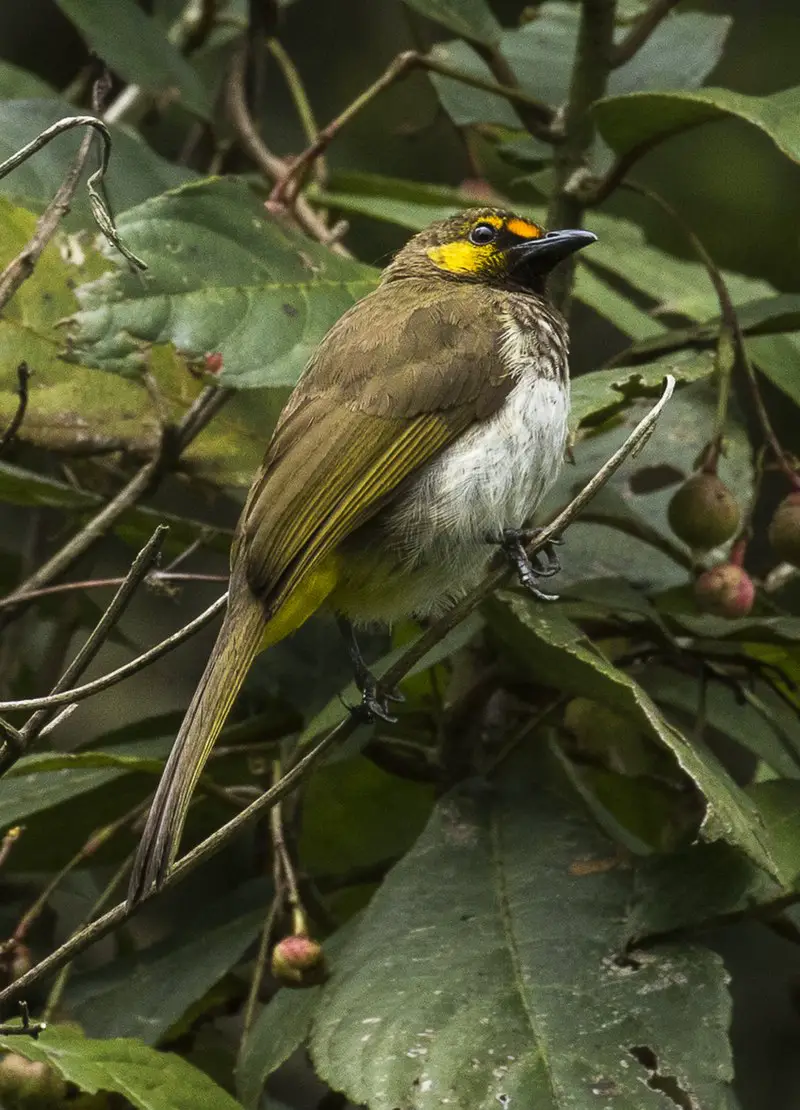
The Orange-spotted bulbul is a beautiful songbird belonging to the bulbul family. It is found only in Java, Bali, and Sumatra. This bird likes living in forest edges and open meadows in montane forests.
It was first classified as a member of the Turdus genus in 1821 by Thomas Horsfield. The Aceh bulbul was previously thought to be a subspecies but has now been recognized as a separate species.
The Orange-spotted bulbul’s attractive appearance and melodious voice make it a favorite among birdwatchers.Scientific classification:
| Kingdom | Animalia |
| Phylum | Chordata |
| Class | Aves |
| Order | Passeriformes |
| Family | Pycnonotidae |
| Genus | Pycnonotus |
| Species | P. bimaculatus |
20. Rufous-Tailed Tailorbird
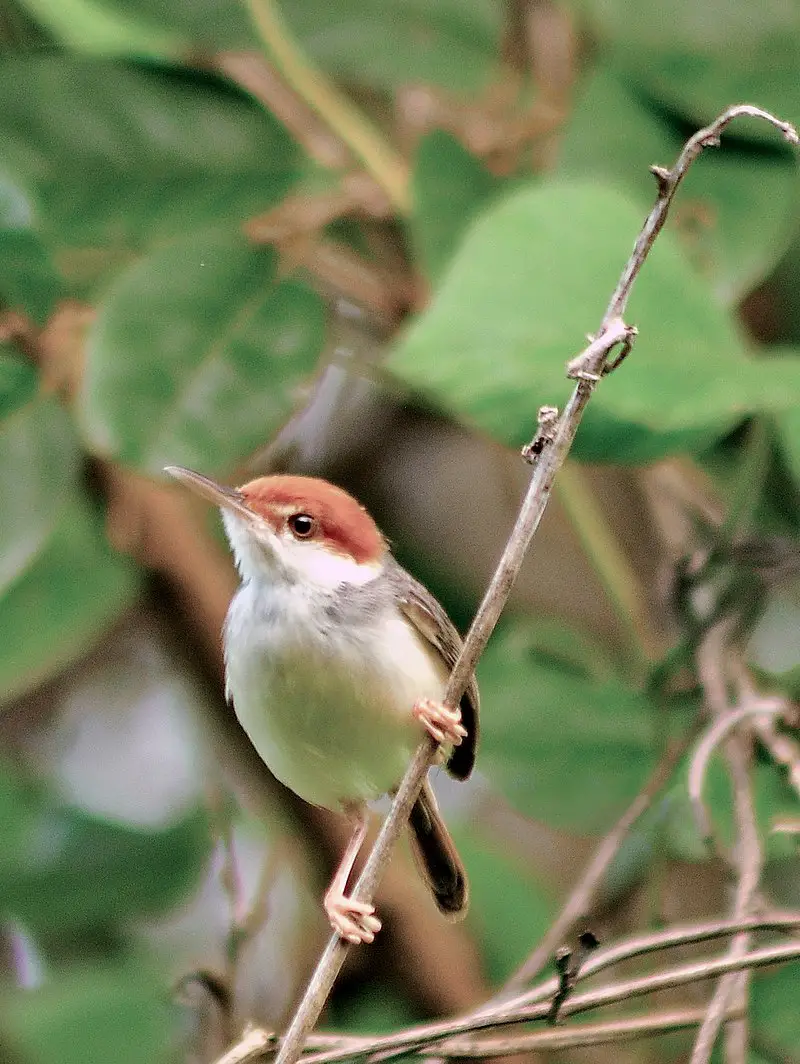
The Rufous-tailed tailorbird is a small bird that is found in various Southeast Asian countries. It was previously considered as part of the Old World warbler’s family but is now classified under the Cisticolidae family.
This bird species typically resides in lowland forests with a subtropical or tropical climate, including mangrove forests.
The Rufous-tailed tailorbird’s long, rufous-colored tail feathers are its distinctive feature. They are expert weavers and possess the unique ability to stitch leaves together to create their homes.
These birds have a varied vocal range, and their calls are often used to communicate with their partners.
They also feed on insects and other small creatures found in their habitat. The Rufous-tailed tailorbird is a beautiful bird that adds charm to the Southeast Asian forests it inhabits.Scientific classification:
| Kingdom | Animalia |
| Phylum | Chordata |
| Class | Aves |
| Order | Passeriformes |
| Family | Cisticolidae |
| Genus | Orthotomus |
| Species | O. sericeus |
Also Featured In: Birds that Live in Kuala Lumpur, Palawan Island Birds
21. Sumatran Green Pigeon
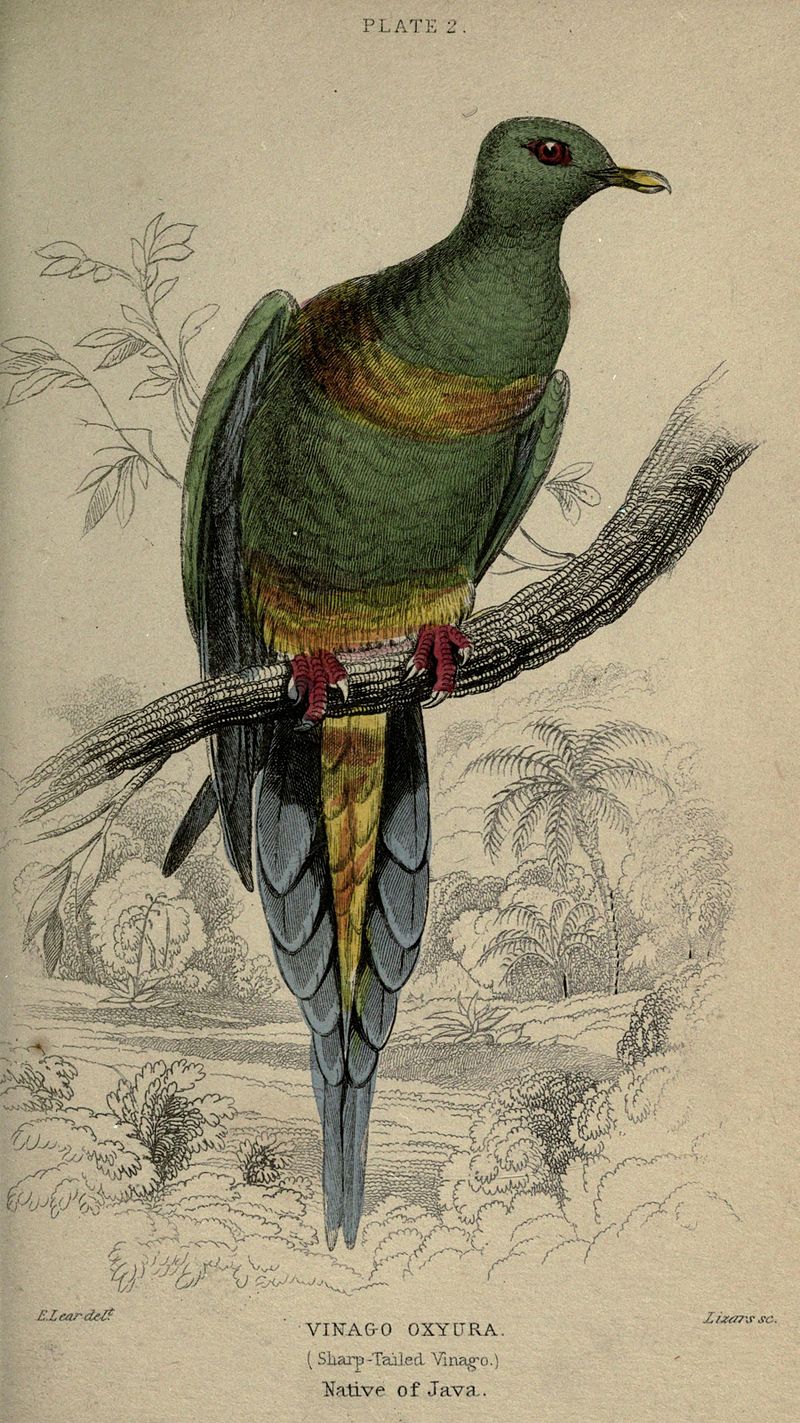
The Sumatran green pigeon is a bird that belongs to the Columbidae family, and it can only be found in Indonesia, specifically in Sumatra and western Java.
This magnificent bird inhabits subtropical or tropical moist lowland forests and subtropical or tropical moist montane forests.
Unfortunately, this species is facing a serious threat due to the loss of its natural habitat caused by human activities.
Nonetheless, its beauty and ecological relevance make it a valuable member of the avian fauna in the region.
The Sumatran green pigeon is cherished for its emerald-green feathers, inspiring wonder and awe to those who witness it in the wild.
Its conservation status remains a priority to protect it from potential extinction, and it reminds us of the importance of preserving natural habitats for biodiversity conservation.Scientific classification:
| Kingdom | Animalia |
| Phylum | Chordata |
| Class | Aves |
| Order | Columbiformes |
| Family | Columbidae |
| Genus | Treron |
| Species | T. oxyurus |
Also Featured In: Common Birds of Indonesia,
22. Jambu Fruit Dove
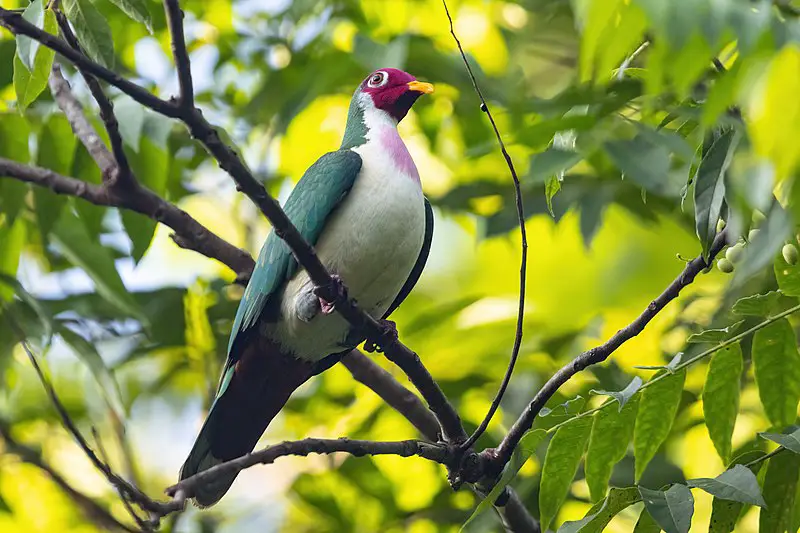
The Jambu fruit dove is a brightly colored bird that is native to Southern Thailand, Malaysia, Brunei, and Indonesian islands.
It is a small bird that primarily feeds on fruits, and its feathers are predominantly green with a reddish-pink crown and breast.
The bird was first described by Johann Friedrich Gmelin in 1789 in his revised edition of Carl Linnaeus’s Systema Naturae. It is a resident breeding species that breeds in the mentioned regions.
Although small in size, the Jambu fruit dove is an important part of the ecosystem, helping to disperse the seeds of the fruits it consumes.Scientific classification:
| Kingdom | Animalia |
| Phylum | Chordata |
| Class | Aves |
| Order | Columbiformes |
| Family | Columbidae |
| Genus | Ptilinopus |
| Species | P. jambu |
23. Javan Woodcock
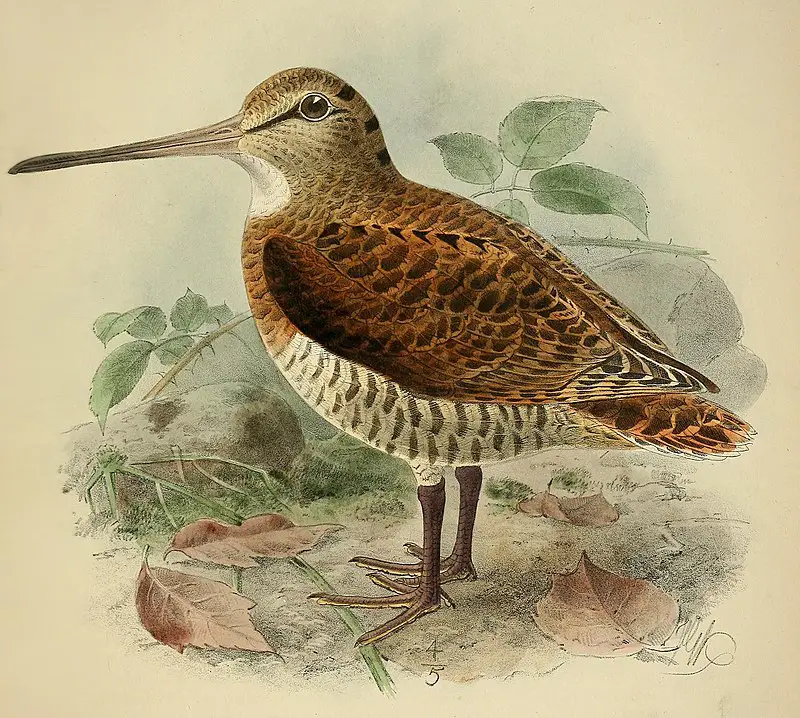
The Javan woodcock, also known as the rufous woodcock, is a wader found in the wet mountain forests of Sumatra and western Java. It nests in light undergrowth, making its bed on a bed of moss.
Similar to the Eurasian woodcock, it performs a “roding” display flight, though with its own unique call.
The Javan woodcock is notably smaller than the Eurasian woodcock and has dark plumage.
In the past, it was grouped with the New Guinean woodcock, but is now considered a separate and distinctive species.
Despite its habitat being threatened by human activity and deforestation, the Javan woodcock has not yet been designated as a species of conservation concern.Scientific classification:
| Kingdom | Animalia |
| Phylum | Chordata |
| Class | Aves |
| Order | Charadriiformes |
| Family | Scolopacidae |
| Genus | Scolopax |
| Species | S. saturata |
24. Salvadori’s Nightjar
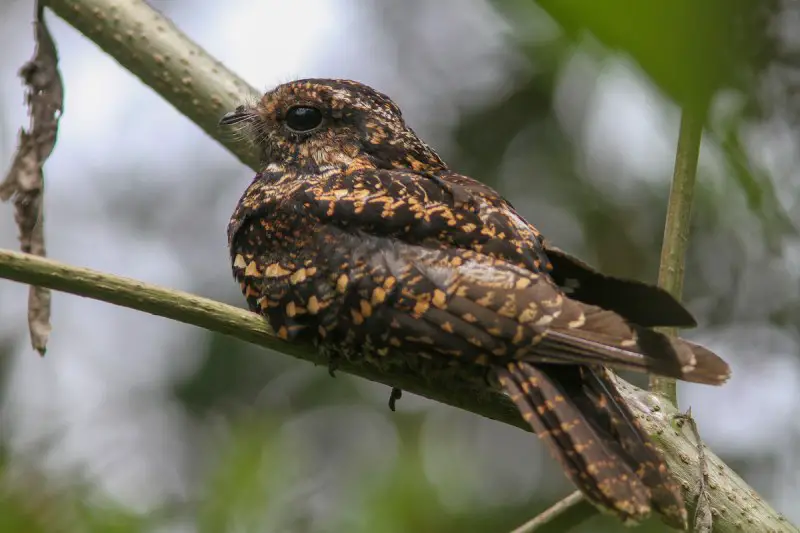
Salvadori’s nightjar, a species of nightjar from the family Caprimulgidae, is found only in Indonesia, specifically in the islands of Sumatra and Java. Its habitats include subtropical or tropical moist lowland and montane forests.
Unfortunately, the bird is currently at risk of habitat loss due to deforestation. Despite its threatened status, it remains an important member of its ecosystem, helping to control populations of insects during the night.
The bird’s physical characteristics are not mentioned in the given information, but it is safe to assume that it shares the same general features as other nightjar species, with a cryptic plumage used to camouflage itself during the day and large, wide mouths used for catching insects at night.Scientific classification:
| Kingdom | Animalia |
| Phylum | Chordata |
| Class | Aves |
| Clade | Strisores |
| Order | Caprimulgiformes |
| Family | Caprimulgidae |
| Genus | Caprimulgus |
| Species | C. pulchellus |
25. Javan Bulbul
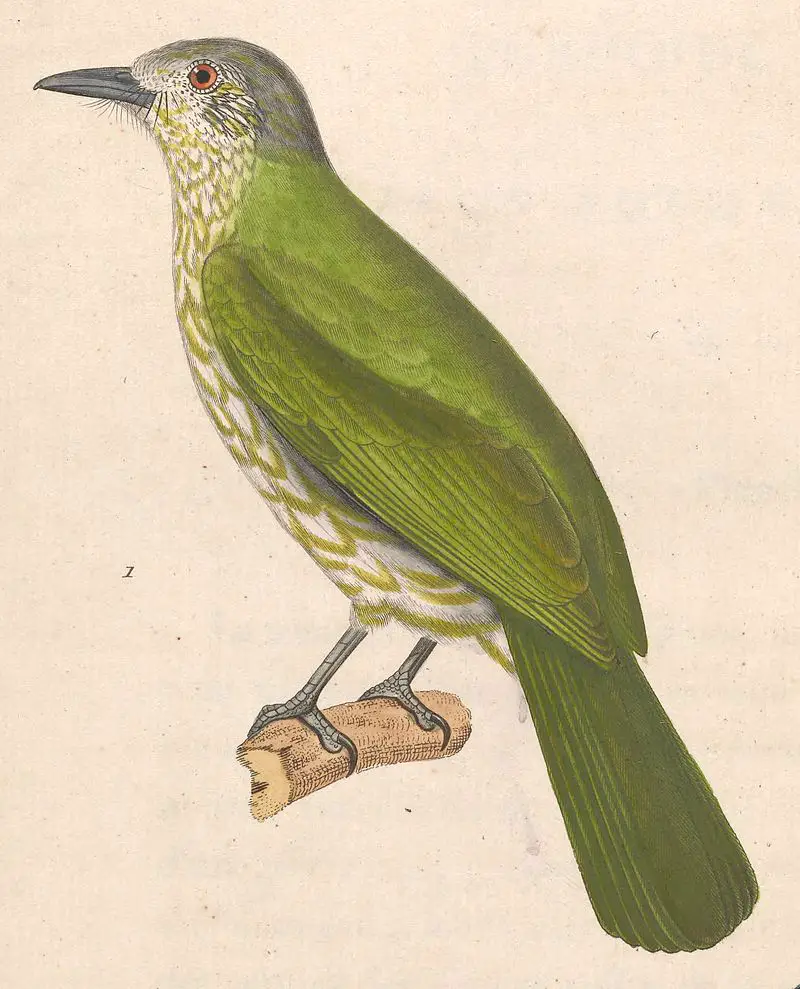
The Javan bulbul is a type of songbird found only in the montane forests of Java, Indonesia. It is the namesake species of the Ixos genus, and is not currently endangered.
Though sometimes classified differently, it is officially part of the bulbul family.Scientific classification:
| Kingdom | Animalia |
| Phylum | Chordata |
| Class | Aves |
| Order | Passeriformes |
| Family | Pycnonotidae |
| Genus | Ixos |
| Species | I. virescens |
26. Sunda Minivet
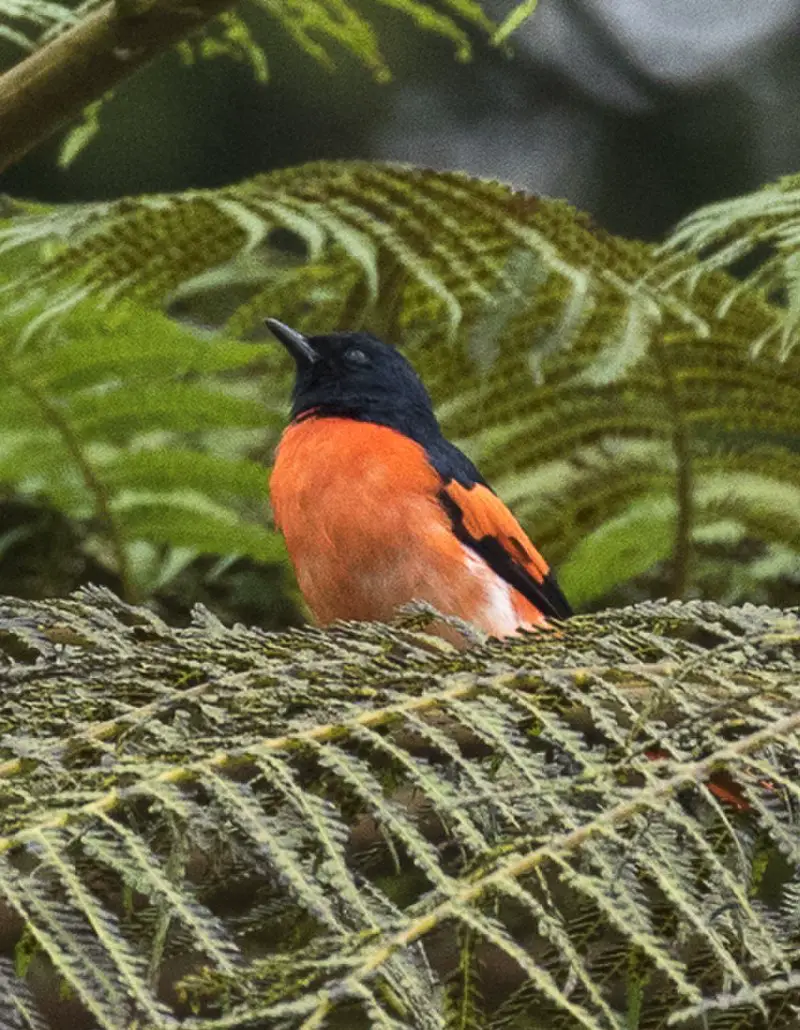
The Sunda minivet bird, a member of the Campephagidae family, can only be found in Indonesia on the islands of Sumatra and Java. It is a colorful bird species with a red head, black wings, and a bright orange body.
The males and females have different colorations, with the females having more muted colors. These birds are known for their melodious singing voices and are often found in the forest canopy, where they feed on insects and small fruits.
The Sunda minivet plays an important role in the ecosystem as a predator of insects, helping to control insect populations.
Despite being endemic to Indonesia, they face threats due to habitat loss and degradation as a result of deforestation and human activities.
Conservation efforts are needed to protect these beautiful birds and preserve their habitat.Scientific classification:
| Kingdom | Animalia |
| Phylum | Chordata |
| Class | Aves |
| Order | Passeriformes |
| Family | Campephagidae |
| Genus | Pericrocotus |
| Species | P. miniatus |
27. Bronze-Tailed Peacock-Pheasant
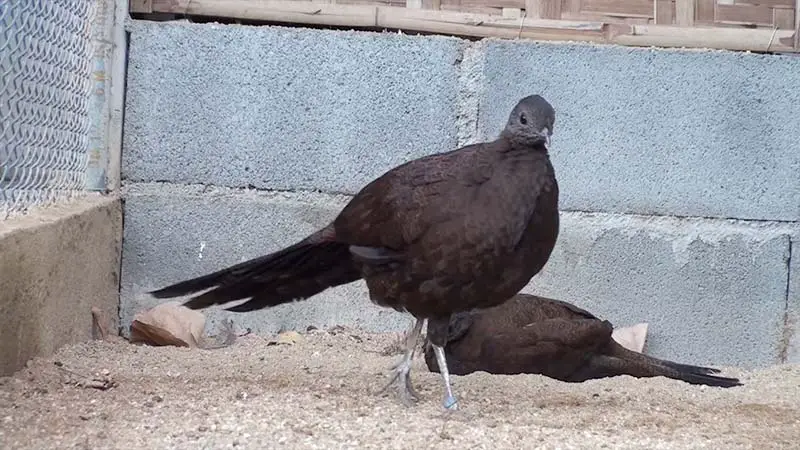
The Bronze-tailed peacock-pheasant, also known as the Sumatran peacock-pheasant, is a small bird found in Indonesia.
It has a dark brown body with a narrow, long tail consisting of sixteen feathers that are chestnut brown and metallic purplish bars near the tips.
The bird has dark grey legs and a relatively small head. Both males and females look alike. The bird is up to 56 cm long and is considered to be an attractive species.
It is known to inhabit the tropical forests of Sumatra and can be seen foraging on the forest floor for insects and seeds.
Unfortunately, this species has experienced a decline in population numbers and is considered to be vulnerable to the threat of habitat loss.
Efforts are being made to preserve and protect its natural habitat in order to ensure the survival of this beautiful bird for future generations.Scientific classification:
| Kingdom | Animalia |
| Phylum | Chordata |
| Class | Aves |
| Order | Galliformes |
| Family | Phasianidae |
| Genus | Polyplectron |
| Species | P. chalcurum |
28. Salvadori’s Pheasant
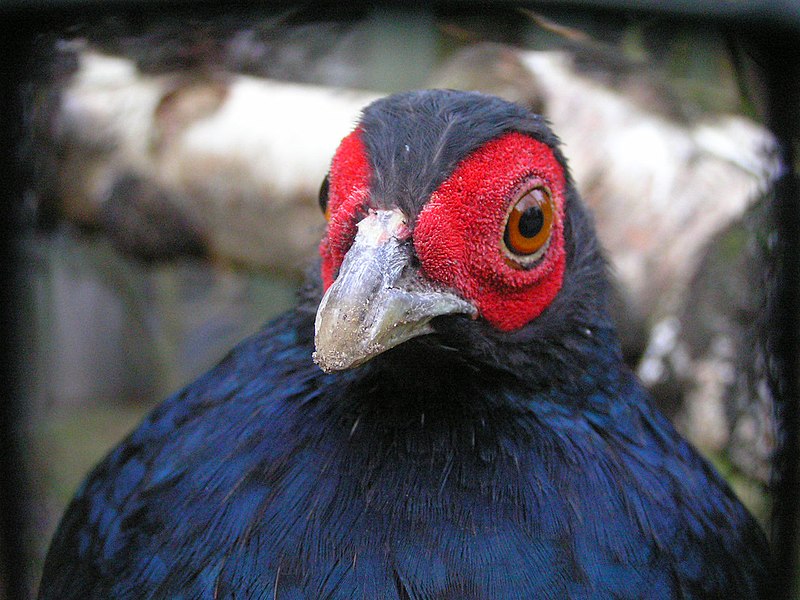
Salvadori’s pheasant, also known as the Sumatran pheasant, is a landfowl bird native to Indonesia. It thrives in the mountain rainforests of Sumatra and was first described by the Italian ornithologist Tommaso Salvadori in 1879.
With its species name meaning “without ornament,” the bird is noted for its unadorned appearance. The Hoogerwerf’s pheasant is believed to be a subspecies of Salvadori’s pheasant.
As a member of the genus Lophura, the bird is an important part of Indonesia’s natural ecosystem.
While it may not have striking physical features, it is a stunning example of the beauty that exists in humble simplicity.Scientific classification:
| Kingdom | Animalia |
| Phylum | Chordata |
| Class | Aves |
| Order | Galliformes |
| Family | Phasianidae |
| Genus | Lophura |
| Species | L. inornata |
29. Spot-Necked Bulbul
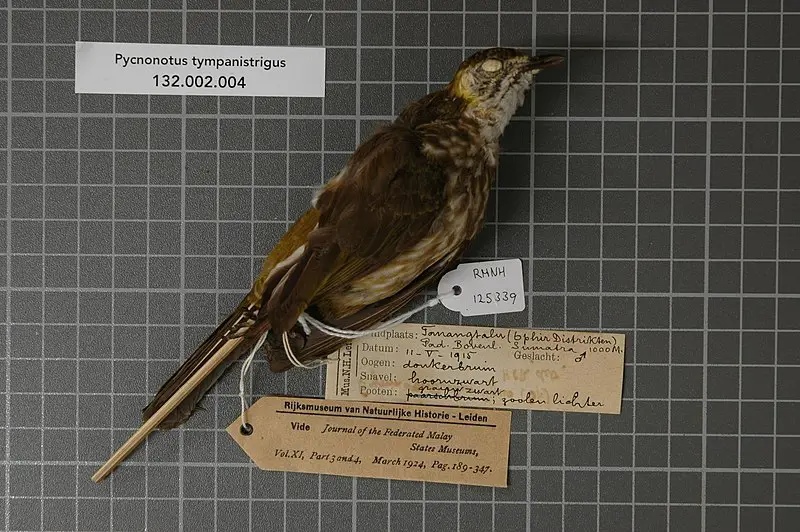
The spot-necked bulbul is a type of songbird that can be found in Sumatra. The bird belongs to the bulbul family, Pycnonotidae, and prefers to reside in subtropical or tropical moist lowland forest and subtropical or tropical moist montane forest.
Sadly, the species is facing a risk of extinction due to habitat loss. The spot-necked bulbul was initially categorized under the genus Ixos and then moved to Pycnonotus.
They are small, beautiful birds with a unique spot on their neck that sets them apart from other bulbul species.
The spot-necked bulbul is known for its melodious chirping that can captivate anyone’s attention.
It is essential to protect their natural habitat and conserve this beautiful bird species so that they can continue to brighten up the world with their sweet songs.Scientific classification:
| Kingdom | Animalia |
| Phylum | Chordata |
| Class | Aves |
| Order | Passeriformes |
| Family | Pycnonotidae |
| Genus | Alcurus |
| Species | A. tympanistrigus |
30. Graceful Pitta
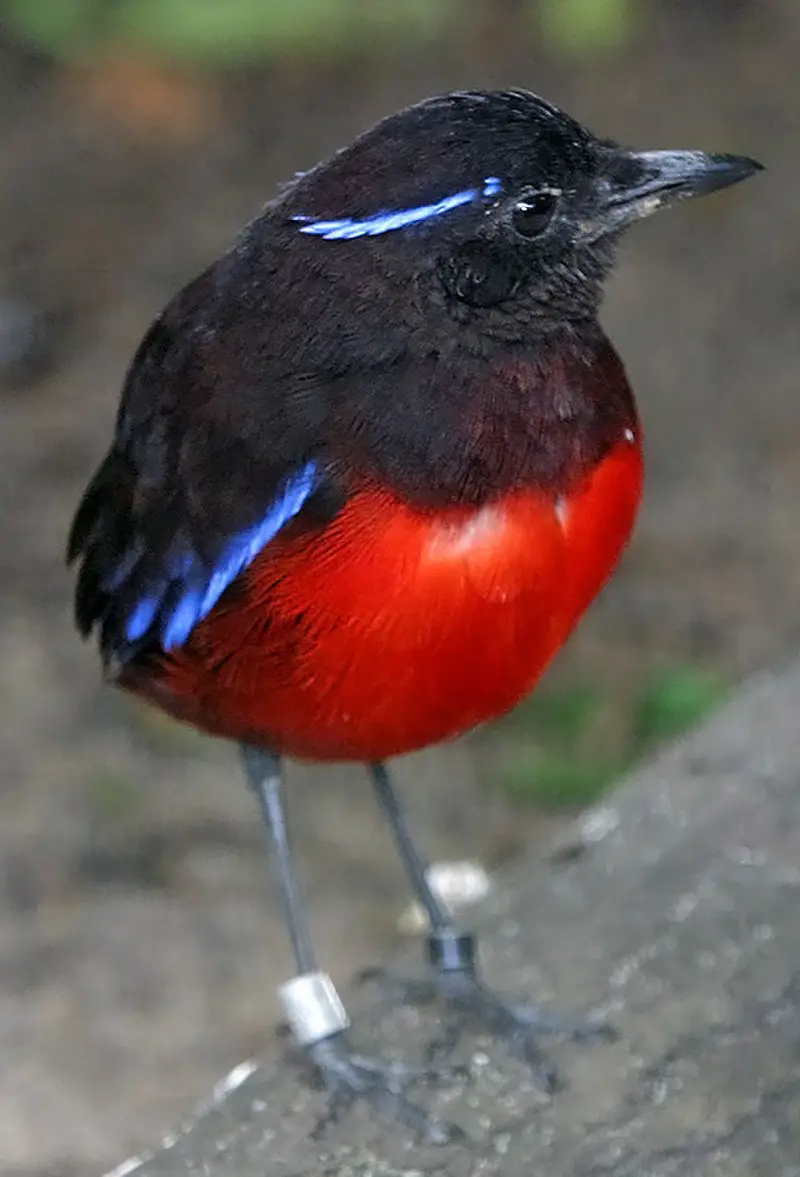
The graceful pitta bird is a member of the Pittidae family and can be found in the subtropical or tropical moist montane forests of Sumatra and Indonesia.
This bird is also known as the black-crowned pitta, although that name is typically used for a different species. Habitat loss is threatening the survival of the graceful pitta, which is known for its stunning and elegant appearance.
The bird’s coloring includes shades of green and blue on its back and wings, with a bright red belly and black crown. Their unique and colorful appearance makes them a popular subject for bird watchers and nature enthusiasts.
Both adult and immature graceful pittas exhibit similar physical features, such as the distinctive black crown and red belly.
Overall, the graceful pitta is a beautiful and fascinating bird that captures the attention of many.Scientific classification:
| Kingdom | Animalia |
| Phylum | Chordata |
| Class | Aves |
| Order | Passeriformes |
| Family | Pittidae |
| Genus | Erythropitta |
| Species | E. venusta |
31. Cream-Striped Bulbul
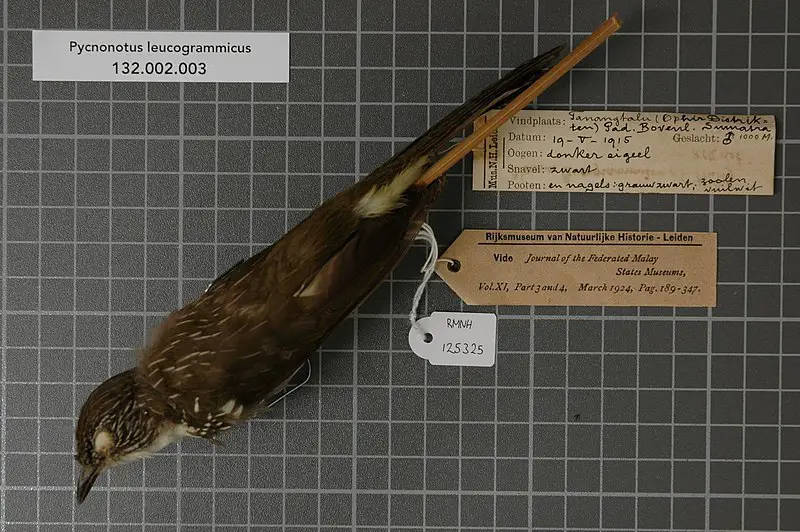
The Cream-striped bulbul is a beautiful songbird belonging to the bulbul family. It can only be found in western Sumatra, Indonesia, making it an endemic species.
Originally categorized under the genus Ixos and later moved to Pycnonotus, it was eventually discovered to be a sister species to the three Hemixos birds. As a result, it was reassigned to the Hemixos genus.
Although no more than 140 words can be used to describe this magnificent bird, its unique characteristics and beautiful appearance are sure to capture the hearts of many bird lovers.
With its cream-colored stripes and melodious songs, the Cream-striped bulbul is sure to be a favorite among many birdwatchers.Scientific classification:
| Kingdom | Animalia |
| Phylum | Chordata |
| Class | Aves |
| Order | Passeriformes |
| Family | Pycnonotidae |
| Genus | Hemixos |
| Species | H. leucogrammicus |